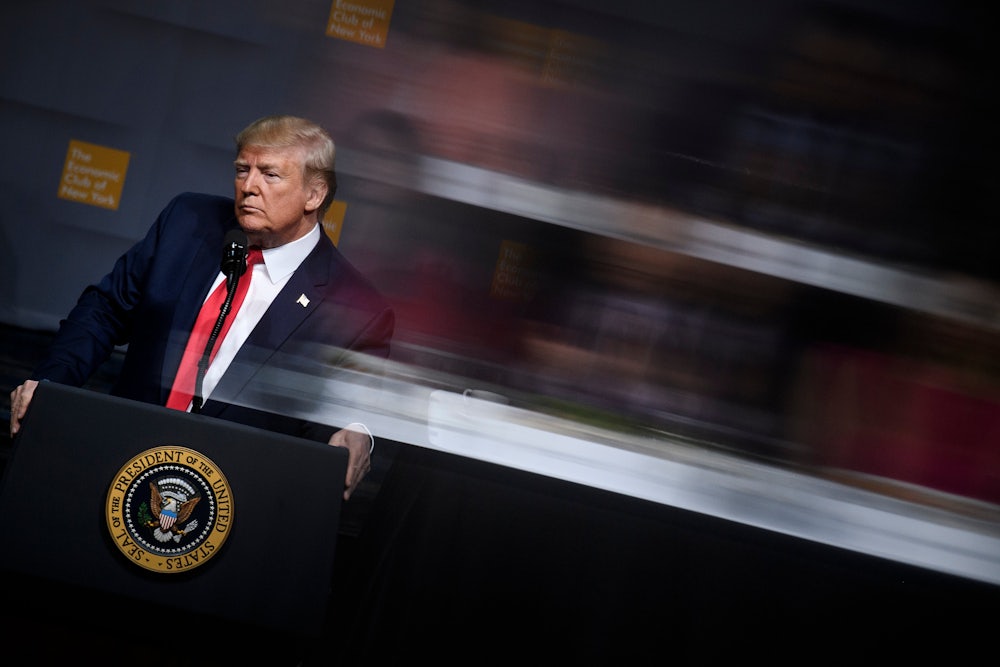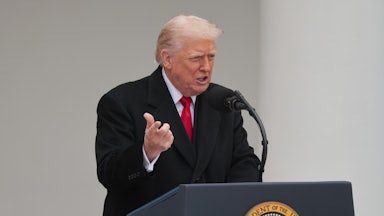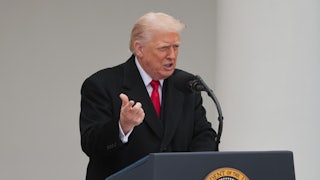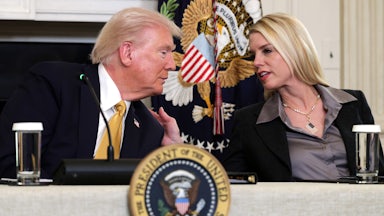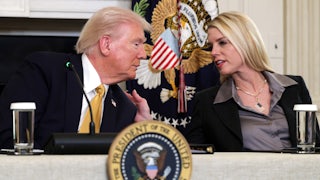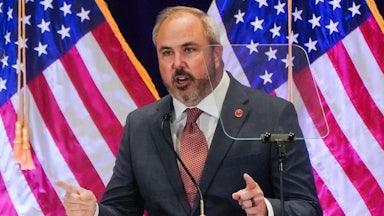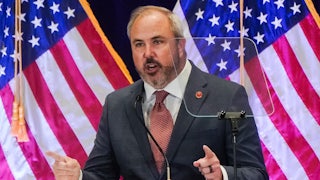Donald Trump aspires to replace the income tax, or as much of it as he can, with revenue from tariffs. He said so last June, and he repeated his intentions in his inaugural address. Yet the financial press keeps scratching its head over why Trump’s starting a trade war with Canada and Mexico by imposing 25 percent across-the-board tariffs and escalating an existing trade war with China by imposing a 10 percent across-the-board tariff. “What exactly is the goal?” asks Lindsay Wise in The Wall Street Journal.
The goal is to raise revenue—more than $1 trillion by one estimation, though that was before Trump lowered the tariff on Canadian oil to 10 percent. And while Trump’s fellow oligarchs may fancy, in theory, gutting the income tax, even they don’t want to pay the financial price—of which Friday’s stock market dive was only the first sign.
Trump’s embrace of the Republican cult of William McKinley—invented a generation ago by Karl Rove—is a vision not, as Rove’s was, of Republican political realignment but rather of eliminating the income tax. Since the 1950s, tariffs have raised no more than 2 percent of federal revenue, but throughout the nineteenth century, except for a brief period during the Civil War, there was no federal income tax and tariffs were the principal source of federal revenue. McKinley was the last Republican president to resist establishing an income tax. Trump wants to bring those days back. Here’s what Trump said in his inaugural address:
Instead of taxing our citizens to enrich other countries, we will tariff and tax foreign countries to enrich our citizens. For this purpose, we are establishing the External Revenue Service to collect all tariffs, duties, and revenues.
Trump doesn’t need to create an External Revenue Service (which would require Congress to pass legislation) to bleed tariff revenue from our trading partners. He just needs a proximate cause. At the moment Trump says it’s to halt the flow of immigrants and fentanyl into the United States, even though crossings on the southern border in 2024 were, at 2.14 million, lower than they’ve been since 2021. Crossings on the northern border are rising, but they still represent less than one-tenth that number. Canada and Mexico have both taken recent steps to reduce these crossings further.
As for fentanyl, Mexico is the principal source, but since 2023 it’s been cooperating with the U.S. on a fentanyl crackdown, extraditing, for example, the Sinaloa Cartel leader Ovidio Guzmán López to the U.S. Trump’s new tariff could easily end that cooperation. Canada sends very little fentanyl into the U.S. because it can’t compete with Mexico’s low labor costs. This past weekend Trump resumed suggesting he was imposing tariffs on Canada to force it to become the fifty-first state. Any pretext, no matter how ridiculous, will do.
A written statement from the White House crows that the North American tariffs will hurt Canada and Mexico more than they hurt the United States, which is probably true. But so what? Since Trump is not using the tariffs, set to take effect Tuesday, as a negotiating tool—before he announced them, he said there was nothing the two countries could do (nor China) to avert them—Canada and Mexico have no avenue for surrender. It little matters that trade (per Trump) represents 73 percent of Mexico’s gross domestic product and 67 percent of Canada’s but only 24 percent of America’s because Trump has no plan to leverage any benefit from reducing it. He just wants the revenue. So all the U.S. gets is the satisfaction that the economic wreckage it experiences—and the estimated one-quarter of GDP is a lot!—won’t be as bad as in Canada and Mexico. Unlike Samson, Trump doesn’t seem to grasp that when you pull down the columns of the temple, you may kill more Philistines but you also kill yourself.
The trade war started even before Trump’s tariffs took effect. Canada responded this weekend with a retaliatory 25 percent tariff on $30 billion in goods from the U.S., with tariffs on an additional $125 billion to follow. (These dollar figures represent Canadian dollars, with the $155 billion total translating to $110 billion in U.S. dollars.) Mexico will retaliate too, especially on agricultural imports. China will likely retaliate by devaluing its currency, thereby shrinking its market for imports from the U.S.
A fascinating irony here is that although Trump wants to displace the IRS with his notional External Revenue Service, thereby ending progressive taxation, the tool he’s using toward this regressive end hurts rich people much more than it does the average Joe.
The most obvious example is the stock market drop; billionaires are harmed much more by a financial downturn than ordinary people. But there are other ways they will suffer more. For example, the tariffs will harm U.S. businesses that import goods far more than it will harm businesses in Canada, Mexico, and China. And a calculation by the nonprofit Tax Policy Center shows that the top 20 percent in the income distribution will lose considerably more income next year from the initial round of tariffs ($3,280) than the bottom 20 percent ($170). That’s a 1 percent hit for the average person at the low end and a 3 percent hit for the average person at the high end. Both cohorts include lots of people who earn below $400,000, on whom even Joe Biden dared not raise taxes!
What’s an oligarch to do? With the most to lose from a trade war, the rich will scramble to end it. The most efficient method to do this may be the oldest one.
Trump’s race to shred what little is left of the Constitution’s emoluments clause, I’ve suggested, is driven in large part by his personal insolvency. I think that’s why Trump puts up with Elon Musk well past the point that Musk’s attention-seeking would have exiled anybody else. Paul Krugman, in his new Substack newsletter, speculates that the Chinese government kept Trump’s China tariff at 10 percent (against 25 percent on Canada and Mexico) by purchasing vast numbers of Trump’s memecoins. That’s pure speculation, but the memecoin racket is not, because somebody is buying up vast quantities of them. Citing a report from Business Insider, Krugman observes that around 40 so-called “whales”—that is, very rich investors—own fully 94 percent of the Trump memecoins. Each of these 40 whales owns more than $10 million of these worthless trinkets.
Have these very rich investors, whose identities are not publicly available, been following some sophisticated investment strategy well beyond the understanding of you and me? No. These purchases are expensive endearments. Whether those extending them include the Chinese government is anybody’s guess. But these whales, whoever they are, want something in return. They’ve created a path for other influence-buyers to follow.
Which may mean Trump’s price for dropping his hugely costly fantasy of resurrecting William McKinley will be not better behavior from China or Mexico or Canada on trade or border crossings or fentanyl, or even Canada becoming the fifty-first state. It may be that Trump is running a straightforward protection racket on his billionaire new best friends. Is that an outrageous accusation? It is. But tell me with a straight face he wouldn’t try it if he could.
